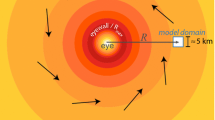Abstract
A fully mature tropical cyclone is a complicated phenomenon, in which effects such as boundary-layer friction, latent heat release, and so on, must be accounted for, in order to give a complete description of the flow. Nevertheless, it is demonstrated here that a two-layer compressible atmosphere model, with a sharp interface separating the layers, is capable of giving a non-linear vortex-type solution at the lowest order of approximation. The ‘eye’ of the cyclone is formed when the interface is drawn down to sea level. Heat energy from the ocean into the cyclone and secondary flow within the vortex are both incorporated. The model provides an approximate description of cyclone behaviour, in terms that are easily understood. More complete descriptions are apparently only possible numerically, however, with a corresponding loss of ease of comprehension.
Similar content being viewed by others
References
F.K. Lutgens and E.J. Tarbuck, The Atmosphere: an introduction of meteorology. Englewood Cliffs, New Jersey: Prentice-Hall Inc. (1979) 413 pp.
Australian Bureau of Meteorology publication, Understanding cyclones: Queensland. Canberra ACT: Australian Government Publishing Service (1992) 17 pp.
H. Holthouse, Cyclone. Adelaide: Rigby publishers (1971) 179 pp.
P.R. Gent and J.C. McWilliams, The instability of barotropic circular vortices. Geophys. Astrophys. Fluid Dynamics35 (1986) 209-233.
R.K. Smith, An analytic theory of tropical-cyclone motion in a barotropic shear flow. Q.J.R. Meteorol. Soc. 117 (1991) 685-714.
G.D. Atkinson and C.R. Holliday, Tropical cyclone minimum sea level pressure/maximum sustained wind relationship for the western north pacific. Monthly Weather Review105 (1977) 421-427.
G.J. Holland, An analytic model of the wind and pressure profiles in hurricanes. Monthly Weather Review108 (1980) 1212-1218.
L.J. Shapiro and M.T. Montgomery, A Three-dimensional balance theory for rapidly rotating vortices. J. Atmos. Sci. 50 (1993) 3322-3335.
J.A. Dutton, The Ceaseless Wind.New York: Dover Publications Inc. (1986) 617 pp.
G.G. Tarakanov, Tropical Meteorology.Moscow: Mir Publishers (1982) 206 pp.
M. Abramowitz and I.A. Stegun (eds.), Handbook of Mathematical Functions. New York: Dover Publications Inc. (1972) 1046 pp.
R.H. Simpson and H. Riehl, The Hurricane and Its Impact. Oxford: Basil Blackwell publisher (1981) 398 pp.
L.K. Forbes and G.C. Hocking, The bath-plug vortex. J. Fluid Mech. 284 (1995) 43-62.
Author information
Authors and Affiliations
Rights and permissions
About this article
Cite this article
Forbes, L.K., Forbes, AM.H. A note on the quantitative structure of quasi-stationary tropical cyclone in the vicinity of the eye. Journal of Engineering Mathematics 33, 1–14 (1998). https://doi.org/10.1023/A:1004240724305
Issue Date:
DOI: https://doi.org/10.1023/A:1004240724305




